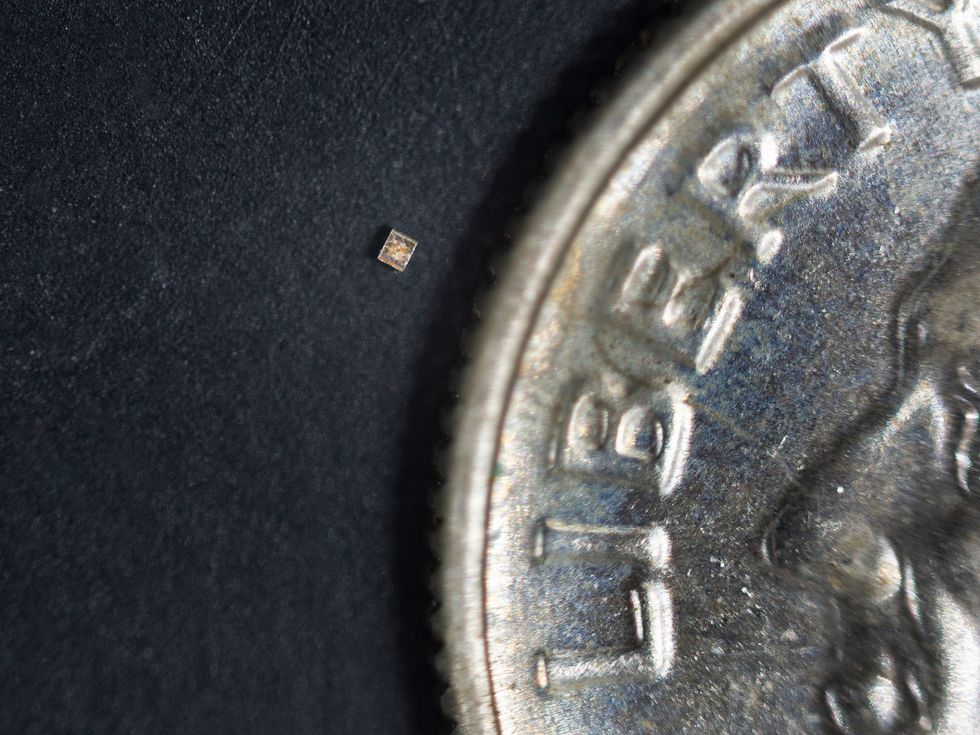To gain a better understanding of the brain, why not draw inspiration from it? At least, that’s what researchers at Brown University did, by building a wireless communications system that mimics the brain using an array of tiny silicon sensors, each the size of a grain of sand. The researchers hope that the technology could one day be used in implantable brain-machine interfaces to read brain activity.
Each sensor, measuring 300 by 300 micrometers, acts as a wireless node in a large array, analogous to neurons in the brain. When a node senses an event, such as a change in temperature or neural activity, the device sends the data as a “spike” signal, consisting of a series of short radio-frequency pulses, to a central receiver. That receiver then decodes the information.
“The brain is exquisitely efficient in handling large amounts of data,” says Arto Nurmikko, a professor of engineering and physics at Brown University. That’s why his lab chose to develop a network of unobtrusive microsensors that are “neuromorphic,” meaning they are inspired by how the brain works. And the similarities don’t end there—Nurmikko says that the wireless signals and computing methods are also inspired by the brain. The team published their results on 19 March in Nature Electronics.
Thinking Like a Brain
Like neurons, these sensors are event-driven and send signals only to the receiver when a change occurs. While digital communication encodes information in a sequence of ones and zeros, this system cuts down the amount of data transmitted by using periods of inactivity to infer where zeros would be sent. Importantly, this leads to significant energy savings, which in turn allows for a larger collection of microsensors.
But with so many sensors sending information to a common receiver, it can be difficult to keep the data streams straight. The researchers deployed a neuromorphic computing technique to decode the signals in real time.
“The brain is exquisitely efficient in handling large amounts of data.” —Arto Nurmikko, Brown University
The researchers also conducted simulations to test the system’s error rate, which increases with more sensors. In addition to 78 fabricated sensors, they ran simulations of networks consisting of 200, 500, and 1,000 nodes using a real data set from primate brain recordings. In each, the system predicted the hand movement of a nonhuman primate with an error rate below 0.1 percent, which is acceptable for brain-computer applications. Nurmikko says the team will next test the wireless implanted sensor network in rodents.
While the technology could be applied to any part of the body where biomedical researchers aim to monitor physiological activity, the primary goal is use in a brain-machine interface that can probe a large region of the brain, says Nurmikko. The sensors could also be modified for use in wearable technology or environmental sensors.
There are key advantages of the system for biomedical uses, such as the small, unobtrusive design. But these applications also impose a key limitation: The sensors are externally powered by a wireless beam to avoid the need for batteries, and the body can only safely absorb so much radio-frequency energy. In other words, the system is not limited by bandwidth, but instead by power delivery. “From a practical point of view, it always comes back to the question of, where do you get your energy?” says Nurmikko.
Brain-Machine Interface Possibilities
The research provides “an important contribution, which demonstrates the feasibility and potential of neuromorphic communications for future use cases of low-power wireless sensing, communication, and decision making,” says Osvaldo Simeone, a professor at King’s College London and one of the researchers who first designed and simulated a neuromorphic communication system, in 2020.
The idea of a wireless network probing the brain is not new, says Federico Corradi, a researcher and assistant professor of electrical engineering at Eindhoven University of Technology, in the Netherlands. In 2011, for example, a researcher at the University of California, Berkeley, gave a presentation on “neural dust” in which he proposed a hypothetical class of nanometer-size wireless sensors. “But now, it’s materializing slowly,” Corradi says.
One important element of the Brown researcher’s design is its simplicity, says Corradi. The sensor’s architecture does not include a battery or clock embedded within the chips, making it ideal for scalable, low-power systems. “It opens a lot of possibilities.”
Additionally, Corradi points to the sensor’s asynchronous nature as a key advantage—and limitation. This aspect of the sensor preserves time information, which is essential for studying the brain. But this feature could also introduce problems if the relative timing of events gets out of whack.
Corradi believes this work is part of a larger trend toward neuromorphic systems, a “new wave of brain-machine interfaces that I hope we will see in the coming future.”
Gwendolyn Rak is an assistant editor at IEEE Spectrum covering consumer electronics and careers. She holds a master’s degree in science journalism from New York University and a bachelor’s degree in astrophysics and history from Swarthmore College.



